With automaker after automaker across the globe ending development of new gasoline powerplants, electric vehicles (EVs) are quickly accelerating us into the future. Whether you crave extreme muscle car levels of performance or enjoy squeezing every drop of economy out of your driving experience, EVs can deliver the best of both worlds.
On the future of EVs, perhaps Bloomberg Media said it best when they wrote, “With all new technologies, there comes a time when buying the older alternative no longer makes sense. Think smartphones in the past decade, color TVs in the 1970s, or even gasoline cars in the early 20th century. Predicting the timing of these shifts is difficult, but when it happens, the whole world changes. It’s looking like the 2020s will be the decade of the electric car.”
For owners of EVs as well as those who aspire to own one, there’s a lot to know about charging them. In this article, we’ll help you gain an understanding of the charging process, factors that affect charging speed, and how EV consumption is measured.
If you’re interested in EV equipment we offer, we invite you to visit our EV Charging section where you’ll find charging stations, charging cords, adapters, and charging cord holsters. Additionally, you may find our related article recommending specific EV charging equipment very helpful (EV Charging Equipment: What You Need to Know)
1. Watts, Volts, and Amps – What Do They Mean?
For this purposes of this article, we’ll start by explaining the basic electrical terms you’ll encounter when it comes to EV charging: watts, volts, and amps. For a moment, imagine electrical flow as water flowing through a pipe. Voltage (measured in volts) equals the water pressure, and current (measured in amps) is the flow rate. Flow rate can be increased by a larger-diameter pipe, or decreased by a smaller-diameter pipe that creates more resistance. Electrical flow works the same way. Watts, which is a measurement of electric power, is equal to volts multiplied by amps. The commonly used term kilowatt is equal to 1,000 watts.
2. Consumption of Electricity and EV Efficiency
When it comes to electrical consumption, the term kilowatt hour (kWh) is a unit of measurement signifying the energy it would take to keep a 1,000-watt appliance running for one hour. For example, a 50-watt light bulb would take 20 hours to use 1 kWh of energy, while a 2,000-watt device would go through a kWh in 30 minutes.
How does that apply to EVs? Since your typical electric vehicle draws more juice than any household appliance, one of the commonly-used ratings for their consumption is kilowatt hours used to travel 100 miles – expressed as kWh/100 miles. For 2022 model EVs sold in the United States, top efficiency winners were the single-motor Tesla Model 3 RWD at 25 kWh/100 miles (4.0 miles per kWh) and the Lucid Air Grand Touring edition at 26 kWh/100 miles (3.8 miles per kWh). For comparison, the dual-motor Ford F-150 Lightning uses an average of 48kWh/100 miles (2.1 miles per kWh).
The U.S. Environmental Protection Agency also creates a miles-per-gallon equivalent measurement known as “MPGe” that equates 1 gallon of gasoline to 33.705 kWh of electricity. Using this scale, the Tesla Model 3 is rated at 132 MPGe, and the Ford F-150 Lightning is rated at 85 MPGe. Similar to how gasoline vehicles are tested for EPA fuel economy ratings, EVs are driven through an identical test course under optimum conditions and temperatures where nothing is being towed and no energy-sucking devices such as a/c, defrosters, heaters, or wipers are in use.
3. “NEMA” Codes for EV Outlets and Plugs – What They Signify
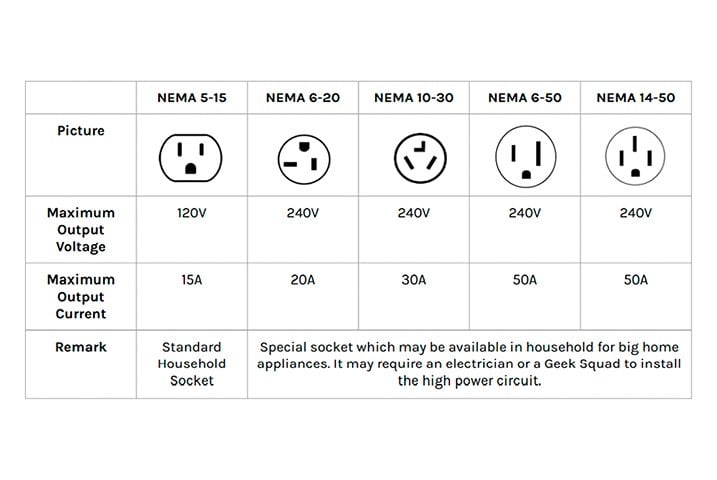
You’ll see adapters and connectors for EVs reference the acronym “NEMA” followed by a two-part number code designation. The “NEMA” letters signify that an outlet configuration meets all standards set by the U.S. National Electrical Manufacturers Association (NEMA). The first digit(s) in the number sequence is a reference to specific socket hole design and layout. The second number refers to the maximum amount of current the outlet can handle in amps. So, for example, “NEMA 5-15” refers to a style 5 outlet that can handle a maximum of 15 amps of electrical current.
4. There are 3 Different Rates of EV Battery Charging
Because the charging rate of different EVs can vary amp-wise from 16 to over 40, it’s important to know the rate your specific make and model is capable of handling before purchasing any charging equipment. Naturally, charging at a higher amp rating will top up your battery faster. But we feel it’s equally important to understand product terms and numbers you’ll encounter looking at adapters and chargers, because these also have a bearing on charging rates.
To simplify things, electric vehicle chargers are uniformly classified as Level 1, 2, or 3 based on the voltage they can handle. Let’s take a look at the specifics.
4.1 LEVEL 1: 110-120 Volts Alternating Current (AC) With a Standard Household Wall Outlet
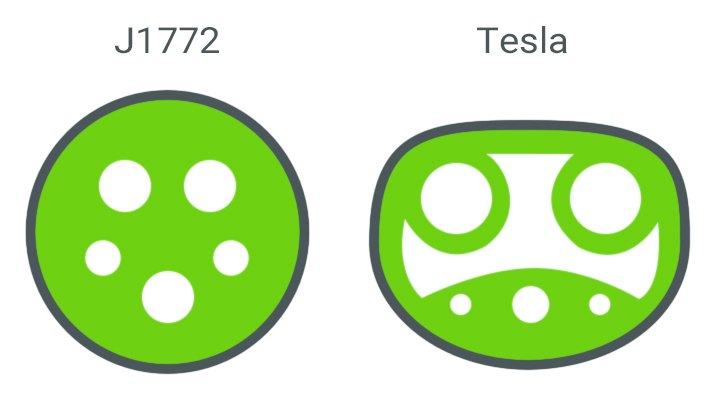
Level 1 charging refers to using a typical household wall outlet which puts out 110 to 120 volts of alternating current (AC) at a rate of 15 amps. This is the slowest method of charging, and will deliver approximately 4 to 6 miles of range per hour. If you drive less than 40 miles per day and can charge for 8 hours overnight, Level 1 charging may be suitable for you.
Most automakers equip their EVs with J1772 style plugs and include a matching level 1 portable charging cord with the vehicle. These cords are fitted with a 3-prong standard wall socket plug on the other end for plugging into any standard NEMA 5-15 household wall outlet. Since Tesla has its own unique charging port, the company provides vehicle owners with its own proprietary level 1 charging cord as well.
4.2 LEVEL 2: 220-240 Volts Alternating Current (AC)

For those that regularly use their vehicle more than 40 miles per day, level 2 charging at a higher rate of 240 volts with 20-40 amps of current is a good solution. Typically, the level 2 rate delivers between 15 and 35 miles of range per hour of charging.
Level 2 charging can be done via a thicker portable cord that plugs into heavy-duty household outlets, or by using private or public charging stations anchored in place. Setups where the charging station draws power from a typical home electric box and billed along with the rest of the property for electricity are known as “non-networked”. Public charging stations run by companies such as ChargePoint, Eaton, EVgo, and others are known as “networked” locations that require a user to set up an individual account for payment.
4.3) LEVEL 3 – 480 Volt Direct Current “Superchargers”
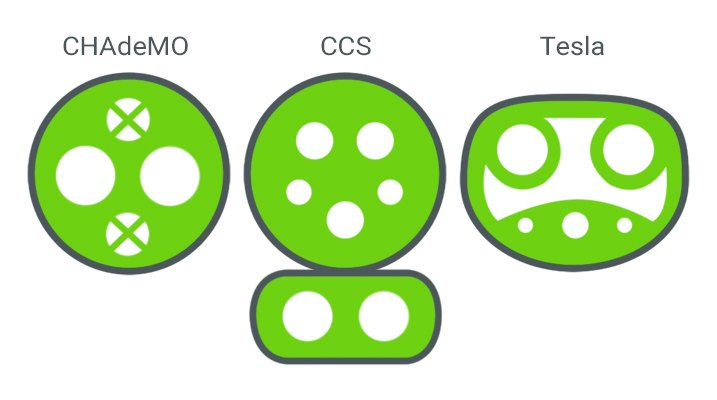
Level 3 chargers, also known as “superchargers”, are the fastest method of charging EVs. Because of their extremely high 480-volt draw, superchargers require heavy-duty commercial planning and wiring that most residential neighborhoods can’t support. For this reason, Level 3 chargers are commercially based charging stations.
It’s interesting to note that EVs have their own built-in rectifier circuits capable of transforming alternating current (AC) from electrical grids and household sockets into direct current (DC) needed for recharging. Because the cost, complexity, and heat involved in rectifying more than 240 volts of AC current at 75 amps is prohibitive, level 3 charging stations put out straight DC current the car can accept easily.
With 100 or more amps (50-60 kW) of DC current charging power at your disposal, you’ll get back on the road relatively quickly at the rate of approximately 175 miles added per charging hour. However, this rate can vary based on the vehicle itself, battery temperature, outside temperatures, and it can be affected by how many other vehicles are using adjacent charging stations at the same time. A more depleted battery will typically charge faster than one that’s half or two-thirds full.
Level 3 charging plugs permit the vehicle to communicate with the charger about how much of a charge it can safely take at any given point. If the battery’s already hot from driving, the vehicle may slow down the charge rate to prevent it from being overheated. To further prevent overheating and shortening of battery life, specific EV models may also have software that prevents the battery from being supercharged above a certain percentage.
Let’s take a closer look at the three different styles of connectors used for Level 3 superchargers: CCS, CHAdeMO, and Tesla.
4.3a) Level 3: Combined Charging System (CCS)
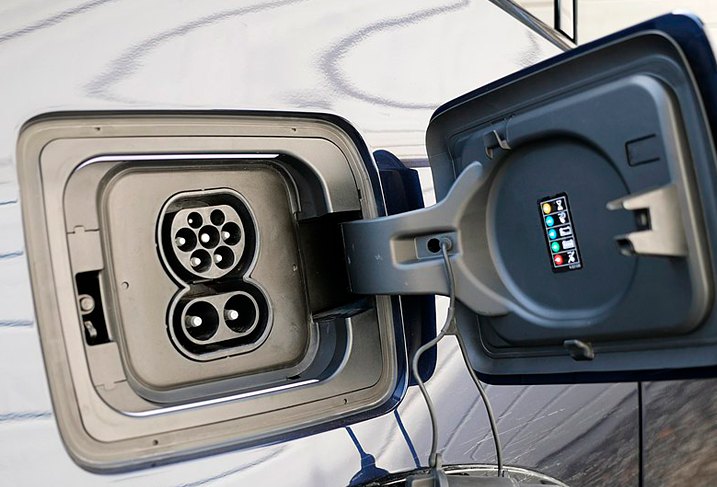
CCS ports allow type 1 and 2 AC charging and DC fast supercharging into the same outlet. More specifically, contacts at the top portion are designed to receive J1772 plugs while two additional direct contacts directly below are used to receive type 3 DC super charging plugs.
4.3b) Level 3: CHAdeMO
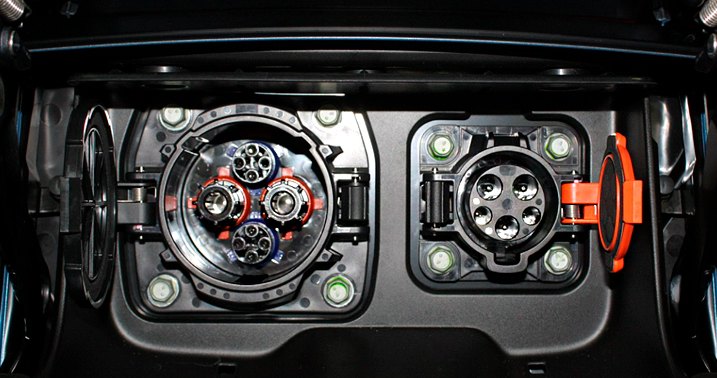
More commonly found across Asia and Europe, the CHAdeMO system of charging was originally created by the Tokyo Electric Power Company and Japanese automakers. Named for an abbreviation of "CHArge de MOve" – a phrase referring to movement created by charging.
Unlike CCS systems, CHAdeMO type 3 systems require a vehicle to be equipped with a dedicated port that’s separate from any others used for type 1 or 2 lower-voltage charging. For this reason, many EVs are equipped with both a CHAdeMO socket and a J1772 socket. Some automakers place these different sockets next to each other while others place them in completely different locations on the vehicle.
4.3c) Level 3: Tesla
Being one of the earliest mass-producers of EVs, Tesla created its own single charging plug that’s capable of handling all three charging rates. Telsa also has its own network of level 3 supercharging stations that only work on Tesla vehicles – requiring confirmation of proprietary info through a data linkup in the plug. For this reason, there are no adapters for charging non-Tesla vehicles at a Tesla charging station.
Tesla claims their level 3 superchargers can now support considerably higher peak charging rates of 250kw which, on paper, equals 1,000 miles gained during an hour of charging. Tesla owners who use these stations claim they haven’t actually seen that kind of charging speed in reality – reporting around 200kw and 800 miles per hour in real world use.

We sincerely hope this article has been educational, and that it eases any fears you may have about EV charging or EVs in general. A number of our staffers have become owners of electric vehicles themselves and say the concerns they had previous to buying one have proven unfounded.
Going forward, we’re enthusiastic about expanding our lineup of EV parts for vehicles such as the Ford Mustang Mach-E, Rivian R1T, Rivian R1S, Volvo XC40, Volvo C40, Tesla Model Y, Tesla Model S, Tesla Cybertruck, Chevrolet Bolt, Volkswagen ID.4, Volkswagen ID Buzz, Kia Niro, Cadillac Lyriq, Hyundai Kona, Hyundai Ioniq 5, BMW i4, BMW iX, BMW iX3, Nissan Leaf, Polestar 2, Audi E-Tron, Audi Q4 E-Tron, Porsche Taycan, Mercedes EQS, Mini Cooper, Chevrolet Silverado EV, GMC Hummer EV, Toyota bZ4X, and more – plus, we look forward to sharing more insights here on CARiD!

